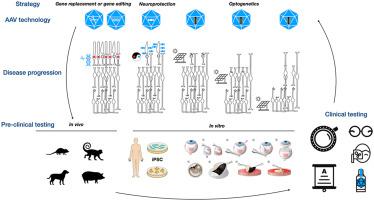Progress in Retinal and Eye Research ( IF 18.6 ) Pub Date : 2021-05-29 , DOI: 10.1016/j.preteyeres.2021.100975 Catherine Botto 1 , Marco Rucli 1 , Müge Defne Tekinsoy 1 , Juliette Pulman 1 , José-Alain Sahel 2 , Deniz Dalkara 1

|
Inherited and age-related retinal degeneration is the hallmark of a large group of heterogeneous diseases and is the main cause of untreatable blindness today. Genetic factors play a major pathogenic role in retinal degenerations for both monogenic diseases (such as retinitis pigmentosa) and complex diseases with established genetic risk factors (such as age-related macular degeneration). Progress in genotyping techniques and back of the eye imaging are completing our understanding of these diseases and their manifestations in patient populations suffering from retinal degenerations. It is clear that whatever the genetic cause, the majority of vision loss in retinal diseases results from the loss of photoreceptor function. The timing and circumstances surrounding the loss of photoreceptor function determine the adequate therapeutic approach to use for each patient. Among such approaches, gene therapy is rapidly becoming a therapeutic reality applicable in the clinic. This massive move from laboratory work towards clinical application has been propelled by the advances in our understanding of disease genetics and mechanisms, gene delivery vectors, gene editing systems, and compensatory strategies for loss of photoreceptor function. Here, we provide an overview of existing modalities of retinal gene therapy and their relevance based on the needs of patient populations suffering from inherited retinal degenerations.
中文翻译:

遗传性视网膜变性的早期和晚期基因治疗干预
遗传性和与年龄相关的视网膜变性是一大群异质性疾病的标志,也是当今无法治愈的失明的主要原因。遗传因素在单基因疾病(如色素性视网膜炎)和具有确定遗传风险因素的复杂疾病(如年龄相关性黄斑变性)的视网膜变性中起主要致病作用。基因分型技术和眼底成像的进步正在完成我们对这些疾病及其在患有视网膜变性的患者群体中的表现的理解。很明显,无论遗传原因是什么,视网膜疾病的大部分视力丧失都是由感光器功能的丧失引起的。光感受器功能丧失的时间和环境决定了每位患者使用的适当治疗方法。在这些方法中,基因治疗正迅速成为临床上适用的治疗现实。我们对疾病遗传学和机制、基因传递载体、基因编辑系统和光感受器功能丧失的补偿策略的理解取得了进展,推动了这种从实验室工作向临床应用的巨大转变。在这里,我们根据患有遗传性视网膜变性的患者群体的需求,概述现有的视网膜基因治疗方式及其相关性。我们对疾病遗传学和机制、基因传递载体、基因编辑系统和光感受器功能丧失的补偿策略的理解取得了进展,推动了这种从实验室工作向临床应用的巨大转变。在这里,我们根据患有遗传性视网膜变性的患者群体的需求,概述现有的视网膜基因治疗方式及其相关性。我们对疾病遗传学和机制、基因传递载体、基因编辑系统和光感受器功能丧失的补偿策略的理解取得了进展,推动了这种从实验室工作向临床应用的巨大转变。在这里,我们根据患有遗传性视网膜变性的患者群体的需求,概述现有的视网膜基因治疗方式及其相关性。










































 京公网安备 11010802027423号
京公网安备 11010802027423号